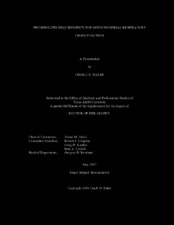| dc.description.abstract | The mitochondrial respiratory chain (MRC) consists of four large protein complexes that catalyze redox reactions driving cellular energy production. These complexes assemble into supra-molecular structures called supercomplexes in the mitochondrial inner membrane. Mitochondrial membrane phospholipid composition is unique and highly conserved, with the bilayer-forming phosphatidylcholine (PC) and non-bilayer forming phosphatidylethanolamine (PE) and cardiolipin (CL) being the most abundant phospholipids. Previous studies highlighted the critical role of CL in MRC supercomplex formation, however, the roles of PE and PC, remained poorly understood. To address this gap in our knowledge, I utilized the yeast Saccharomyces cerevisiae as a model organism to dissect the role of PE and PC in MRC biogenesis.
By performing biochemical analysis of yeast mutants of PC, PE and CL biosynthesis, I discovered a specific requirement for non-bilayer forming phospholipids in MRC biogenesis. Specifically, I showed that PE is required for MRC complex III and IV activities, whereas the loss of the most abundant phospholipid PC does not affect MRC function. Unlike CL, neither PE nor PC is required for MRC supercomplex formation. Furthermore, I found that the loss of mitochondrial PE biosynthesis could be compensated by exogenous supplementation of ethanolamine, a PE precursor, suggesting the existence of a mitochondrial PE import pathway.
The non-bilayer phospholipids PE and CL have been proposed to have overlapping functions, raising an intriguing possibility that elevating mitochondrial PE may compensate for CL deficiency. To test this hypothesis, I utilized an ethanolamine iii supplementation strategy and demonstrated that ethanolamine rescues the respiratory growth of CL deficient cells by promoting MRC supercomplexes. Surprisingly, the rescue was independent of PE biosynthesis and was solely dependent on ethanolamine. This exciting finding has important biomedical implications in the treatment of Barth syndrome, a rare genetic disorder characterized by CL deficiency.
Finally, I describe how the inhibition of non-mitochondrial PE biosynthesis by meclizine, an over-the-counter anti-nausea drug, attenuates respiration by elevating phosphoethanolamine, a PE precursor. Together, the research presented in this dissertation uncovers the specific roles of phospholipids in MRC biogenesis and describes novel approaches for manipulating MRC function that can be utilized for the treatment of mitochondrial disorders. | en |


